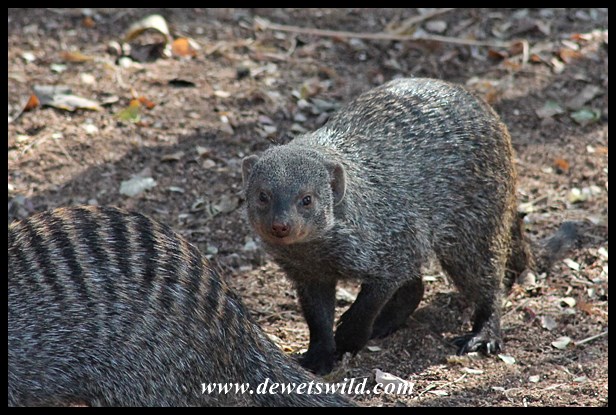Mungos mungo
The diurnal Banded Mongoose inhabits woodland and savanna, showing a strong preference for areas along rivers and marshes with an abundance of logs and termite mounds. These little carnivores prey on insects (especially dung beetles and their larvae), other invertebrates, amphibians, reptiles (including venomous snakes), birds, eggs and rodents, and occasionally also eat fruit. They grow to longer than half a metre, and weigh between 600g and 2kg.
Banded Mongooses live in troops usually numbering from 5 to 30 though exceptionally up to 75, roaming a small home range of up to 4km², within which they have a number of dens used intermittently. These dens are usually holes dug by themselves or other animals, often in termite mounds, or crevices in rocky hills. Though they are not strictly territorial, conflict does sometimes erupt when neighbouring troops meet. Banded Mongooses often associate with warthogs and baboons.
Banded Mongoose pups are born at anytime of the year, though usually in the spring or summer. Most females in the troop get babies at more or less the same time, and the little ones will drink from any lactating female. Litters number from 2 to 8, and the babies tag along with the troop when they go searching for food from about 5 weeks old. Fewer than half of the babies live to 3 months of age, though they can live to between 8 and 13 years. Large raptors and medium-sized mammalian carnivores (jackals, servals, wild dogs, etc.) pose the biggest threat to Banded Mongooses.
The Banded Mongoose has a wide distribution over most of Sub-Saharan Africa, although they are rare in West Africa and absent from the equatorial forests of Central Africa and the arid south-west of the continent. The IUCN regards it as being of least concern, siting its wide distribution, stable and common populations in suitable habitat, presence in major conservation areas and adaptability to human encroachment. In South Africa they are found in the provinces of Kwazulu-Natal, Mpumalanga, Limpopo, Gauteng and North West.






























Somehow this post reminded me of Rikki-Tikki-Tavi
LikeLike
In that case you might be pleased to know that we’ve lined up another post about a different mongoose species for this coming Sunday, Cayenne!
LikeLiked by 1 person
I’m glad to hear that! I’ll look forward to it
LikeLiked by 1 person
That’s another animal I would love to see.
LikeLike
Always a treat to find a pack of these little guys, Montucky.
LikeLike
I miss the annual visits of the band that used to breed under the floorboards of our previous home. They are delightful little creatures. Your pictures show the banded pattern beautifully.
LikeLiked by 1 person
How wonderful that they thought your home and yard a place safe enough for them to rear their young!
LikeLiked by 1 person
We felt privileged. A lot of breeding happened there, actually. A hadeda nest, robins, weavers, yellow billed kites, toads and frogs, land crabs, sundry snakes, skinks, chameleons and geckos, and it was one of the vervet sleeping spots in the area.
LikeLike
An urban wildlife paradise for sure!
LikeLike
Love the pictures! When I was a kid we read ‘Rikki-Tikki-Tavi’ at school, the story of a mongoose. I can’t remember what happened, I just remember it was written by Rudyard Kipling! Most fascinating is that I think they eat snakes?
LikeLiked by 1 person
Indeed, even venomous snakes Jude!
LikeLike
🐍🐍🐍☺
LikeLiked by 1 person
Nice pictures of beautiful animals. 🙂 You can see that it is related to the suricate, in certain positions it does.
LikeLike
Thanks, John! In fact, they and the suricate (or meerkat) utilise the same ecological niche – the suricate in the more arid areas and the banded mongoose in the wetter parts of the country.
LikeLiked by 1 person
Hi guys. I love these little creatures and see them quite often in the bushy area across the road from my house. Definitely a reminder of my childhood reading of Rudyard Kipling.
LikeLike
How lucky you are to have them so close by, Kim!
LikeLike
Fewer than half live to 3 months of age yet they are still of least concern? Poor babies.
LikeLike
It’s a hard life out there in the wilds of Africa, Lois!
LikeLike
Rikki Tikki Tavi!! 🙂 So cute.
janet
LikeLike
A firm favourite for many people, Janet!
LikeLiked by 1 person